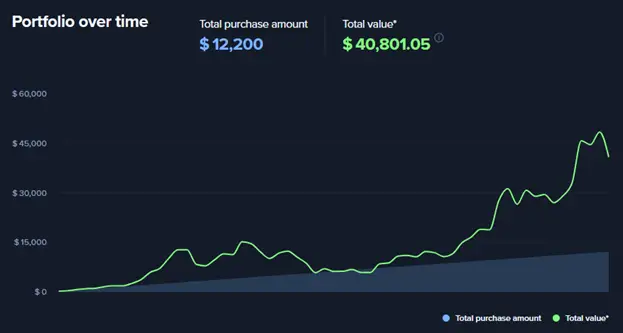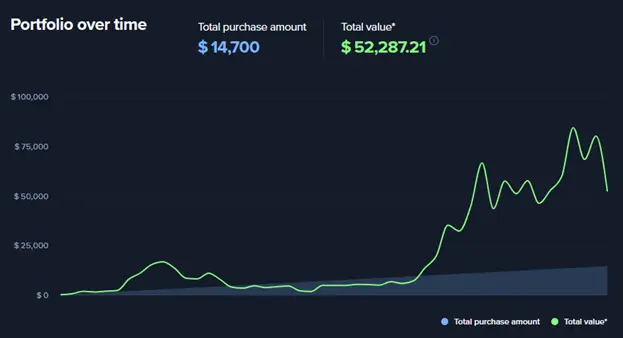DCA (“Dollar Cost Averaging” or “Avoiding dollar value”) is a regular investment method in which a fixed amount of money in an asset is invested on an ongoing basis, regardless of how its price changes. For example, you invest $ 100 in cryptocurrency every month, regardless of fluctuations in the course. That is, you are not trying to predict when the price is low. This creates a long -term averaging strategy, where the cost of each purchase varies depending on market fluctuations. It avoids problems with buying at the peak and reduce “emotional” risks in trade.
Advantages of DCA
One of the main advantages of DCA is that you are not subjected to psychological pressure, trying to guess the perfect moment for entering. Investing regularly you avoid excessive stress and emotional solutions, which is important for a long -term strategy. Indeed, in trading, it is often difficult not to panic at the moments of volatility or euphoria in moments of growth. In fact, this is a disciplining strategy.
The main plus of DCA compared to a one -time investment in an asset is that you reduce the likelihood of buying at a local peak. Suppose the investor decided to once buy BTC for $ 1,000. If the purchase is at the time when the market is on top, the price of the asset may drop sharply, and the investor will have to sell with a loss, or wait a long time to recovery. DCA avoids this, because the purchase of an asset occurs gradually, at different levels of price.
DCA and cryptocurrency
Of course, the DCA strategy itself does not allow to predict the further dynamics of the asset. But we can evaluate past dynamics and, based on retrospective data, understand how effective this strategy was at different time intervals and at different amounts of investment. For this, there are special DCA-calculators. Here is an example of calculating profitability by DCA strategy using a similar service:

Source: uphold.com/en-eu/dca-calculator
Imagine that you started investing in BTC for $ 200 per month from April 2020 to April 2025 inclusive. In total, in five years you would invest $ 12,200. Depending on the price fluctuations, you could buy bitcoin both at lower and higher prices. As a result, the average purchase rate would be lower than if you invested the entire amount immediately at the peak.
Thus, for the specified period, as of April 2025, your investments would be approximately 0.47906 BTC (or about $ 40.801 at the course of the last month of DCA). This would make it possible to get $ 28,601 (234%) in excess.
Consider another example. Suppose you purchased SOL worth $ 300 every month from April 2021 to April 2025 inclusive. During this period, you would invest $ 14,700. As a result, 361.11198 SOL or $ 52,287 would have been released. The total profitability in four years would be even higher than the yield of bitcoin in five years. In excess of investments, it would be $ 37,587 (255%).

Source: uphold.com/en-eu/dca-calculator
The disadvantage of DCA-calculators is that we get only approximate data on profitability. Not all services publicly disclose the methodology and all calculation details. On the other hand, we can conduct a similar retrospective analysis on our own. In this case, you can take as a basis the courses of a particular exchange and accurately set the time of purchase of an asset, for example, a day with a weekly or monthly DCA, and hours and minutes with a daily DCA.
DCA and Value Averaging
One of the similar well -known strategies that can be used for long -term investments is “Value Averaging” (VA or “Availability of Value”). This strategy is similar to DCA, but has an important difference: if you always invest the same amount under DCA, then with VA the size of monthly investments changes depending on how the cost of the asset changes. When the price grows, you invest less when it falls – more. VA is more sensitive to the current market situation, but at the same time requires more involvement and market analysis.
More complex combinations of long -term strategies can weave the DCA, VA methods and even technical analysis. For example, it is possible to practice periodic investing not a specific amount, but a predetermined range. That is, not $ 200 monthly, but an amount from $ 100 to $ 300. Moreover, with the help of indicators of technical analysis, such as RSI, MACD and others, it is possible to successfully determine the local entry points, you can invest a certain amount within the framework of a given range. But such trade will not be a “classic” following DCA.
How to use DCA correctly
In order for the DCA strategy to be effective, several key conditions must be observed:
-
Regularity – investments should be stable and constant.
-
A reliable asset – you need to invest in assets that demonstrate long -term growth and stability.
-
Long -term nature – DCA works best when the strategy is aimed at long -term investments. The cryptocurrency market can be volatile in the short term, but on a long horizon, successful averaging can lead to an increase in the cost of an investment portfolio.
Disades DCA
Of course, DCA has disadvantages. For example, if the cryptocurrency market will decrease for a long time, you continue to invest, but do not see quick results. In addition, if the selected asset is unsuccessful, the strategy will not protect against losses. It is also worth remembering that the successful use of DCA requires discipline – it is important to regularly invest and not deviate from the strategy, even when the market “falls”.
Conclusion
The main plus of DCA is stability. You do not experience stress due to sharp fluctuations in the market, do not try to catch the perfect point for entering, but simply invest regularly, creating an accumulation for the long term. If you want to actively earn with trading, DCA can be an excellent base for compiling more complex strategies, for example, combined with technical analysis or Value Averaging
This material and information in it is not an individual or other other investment recommendation. The view of the editorial office may not coincide with the opinions of analytical portals and experts.
Source: Bits
I am an experienced journalist, writer, and editor with a passion for finance and business news. I have been working in the journalism field for over 6 years, covering a variety of topics from finance to technology. As an author at World Stock Market, I specialize in finance business-related topics.







